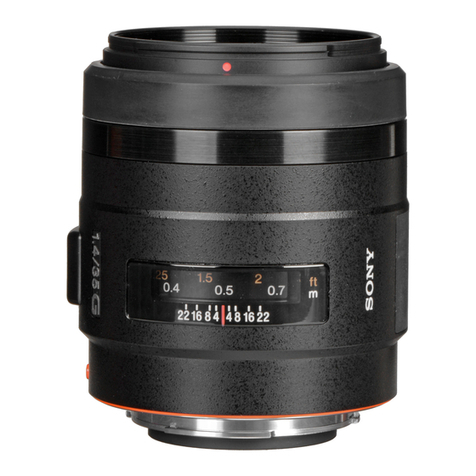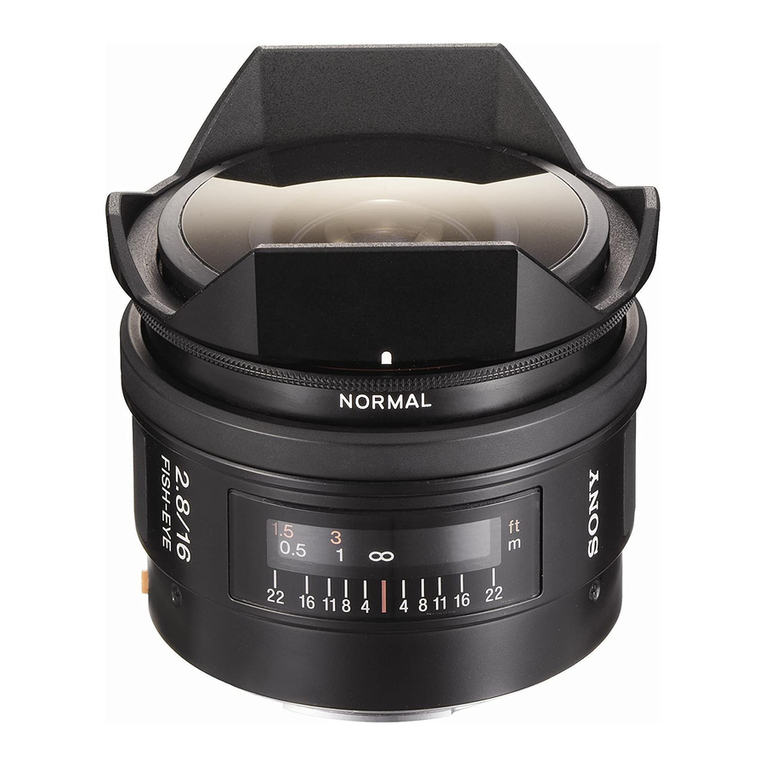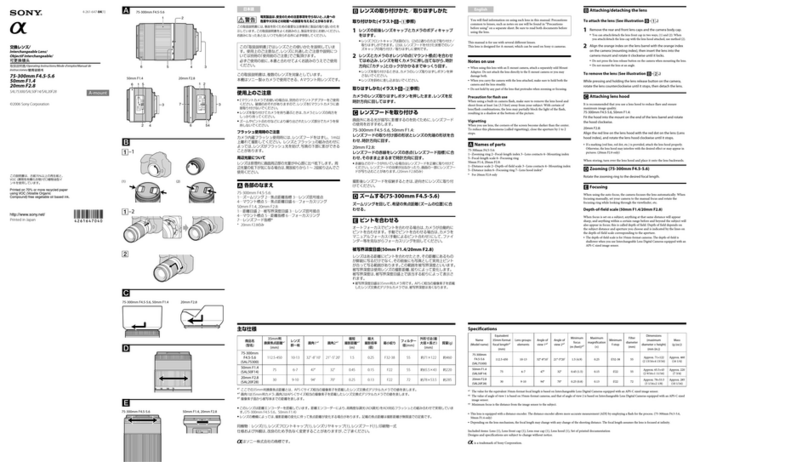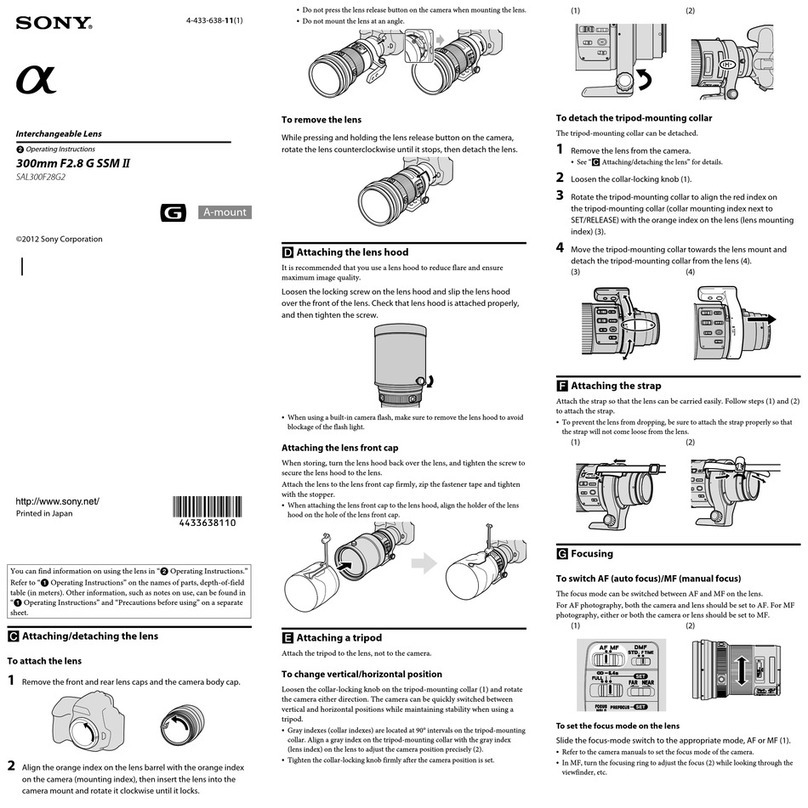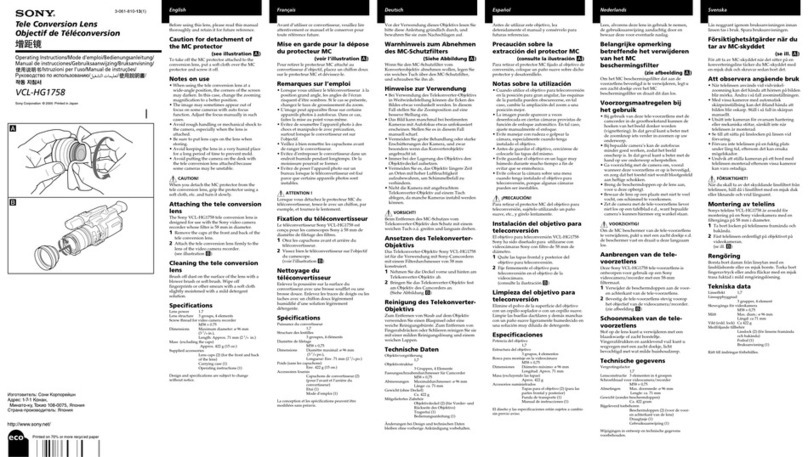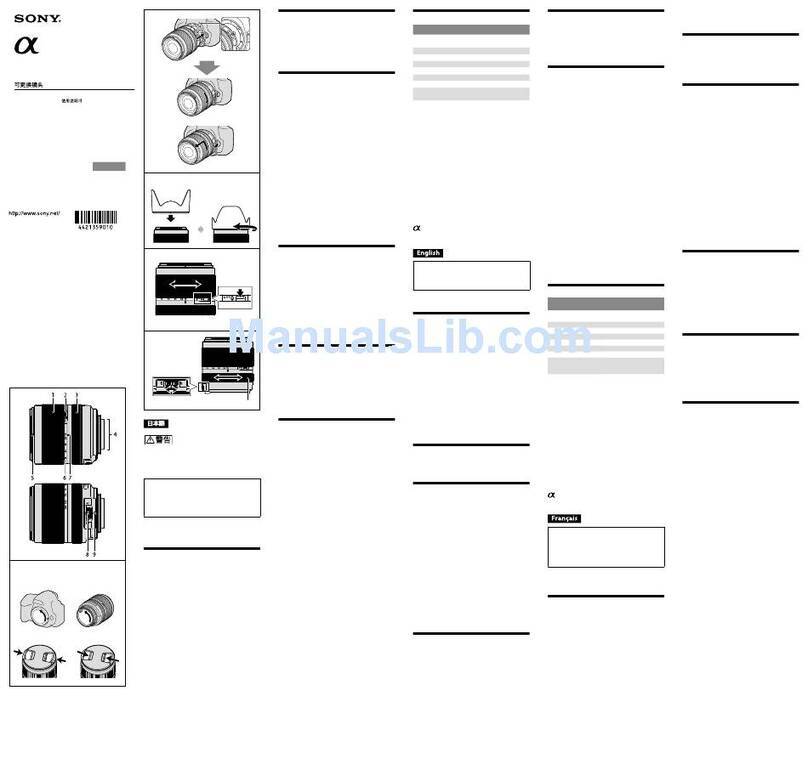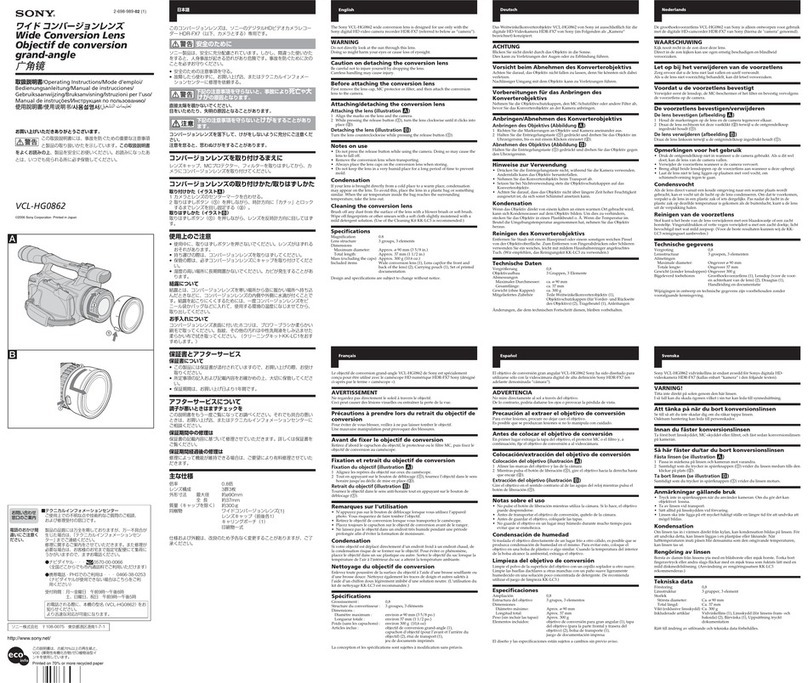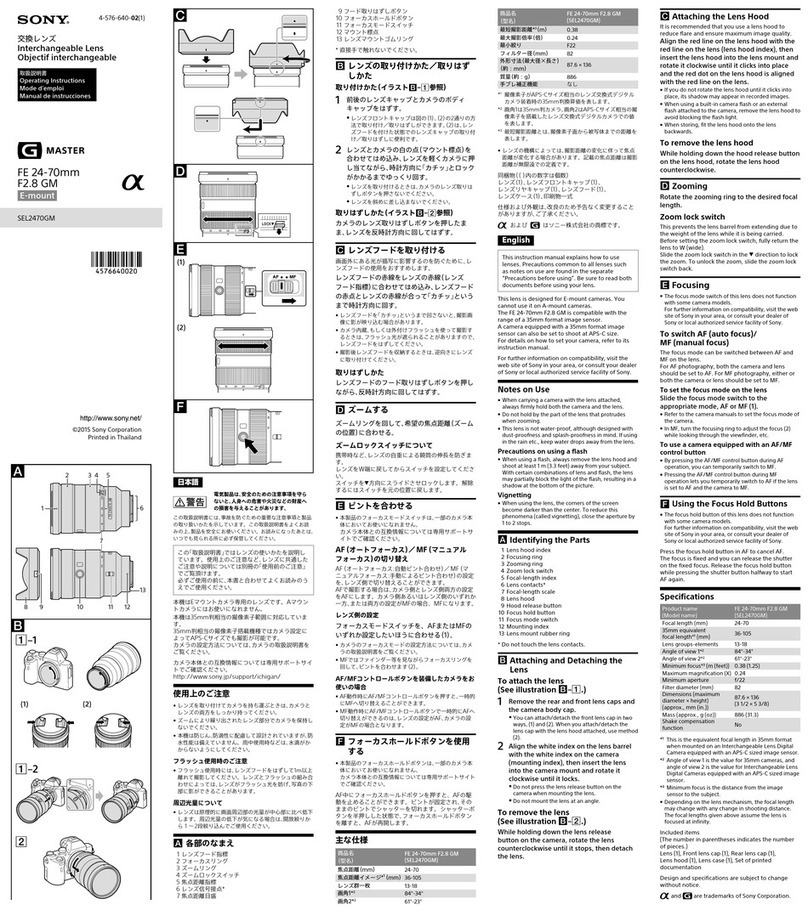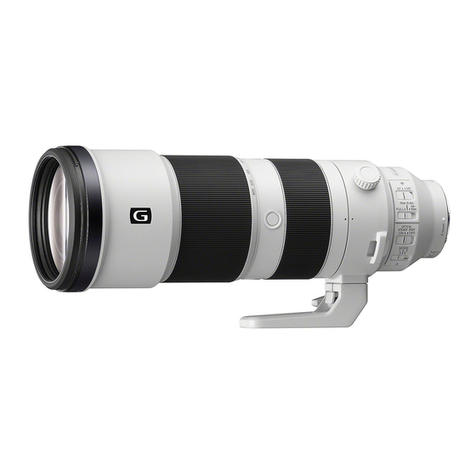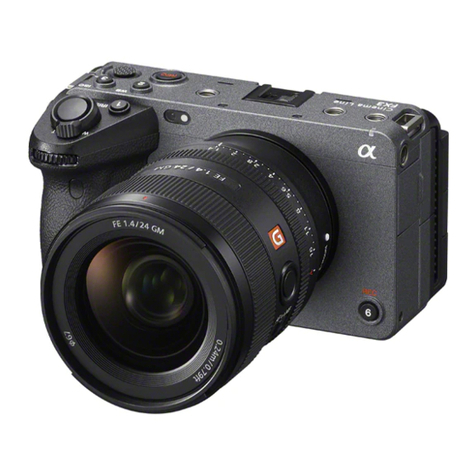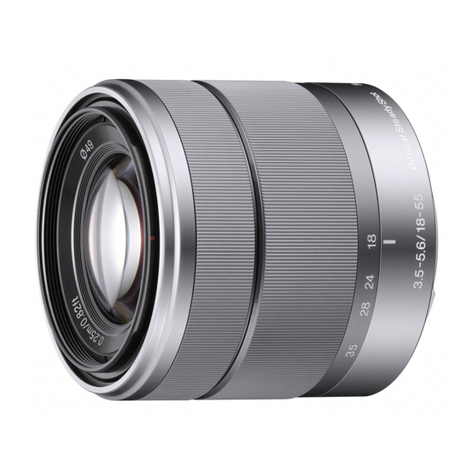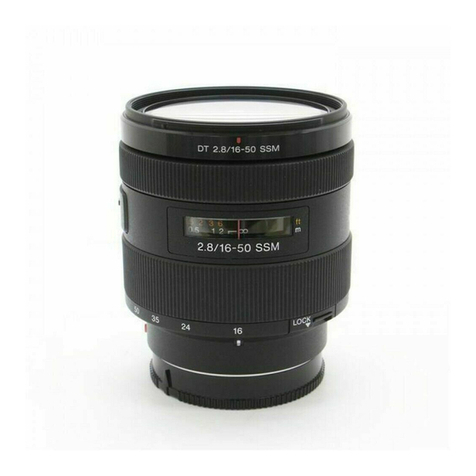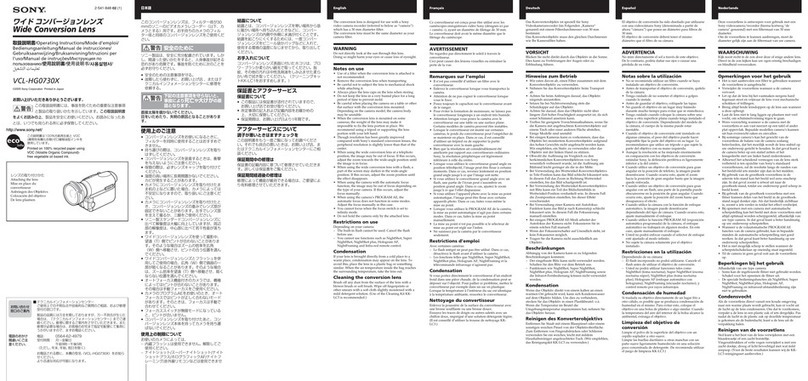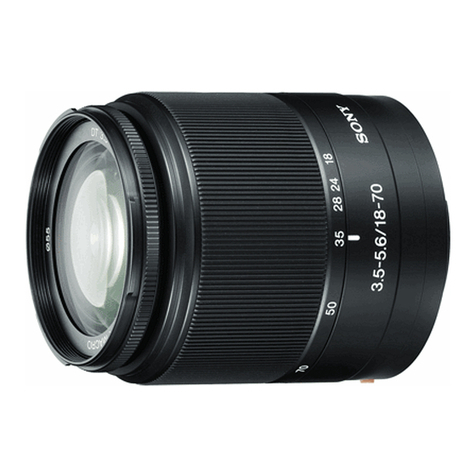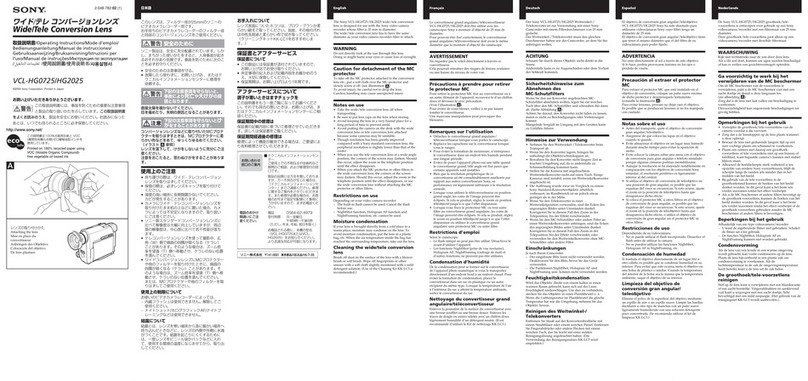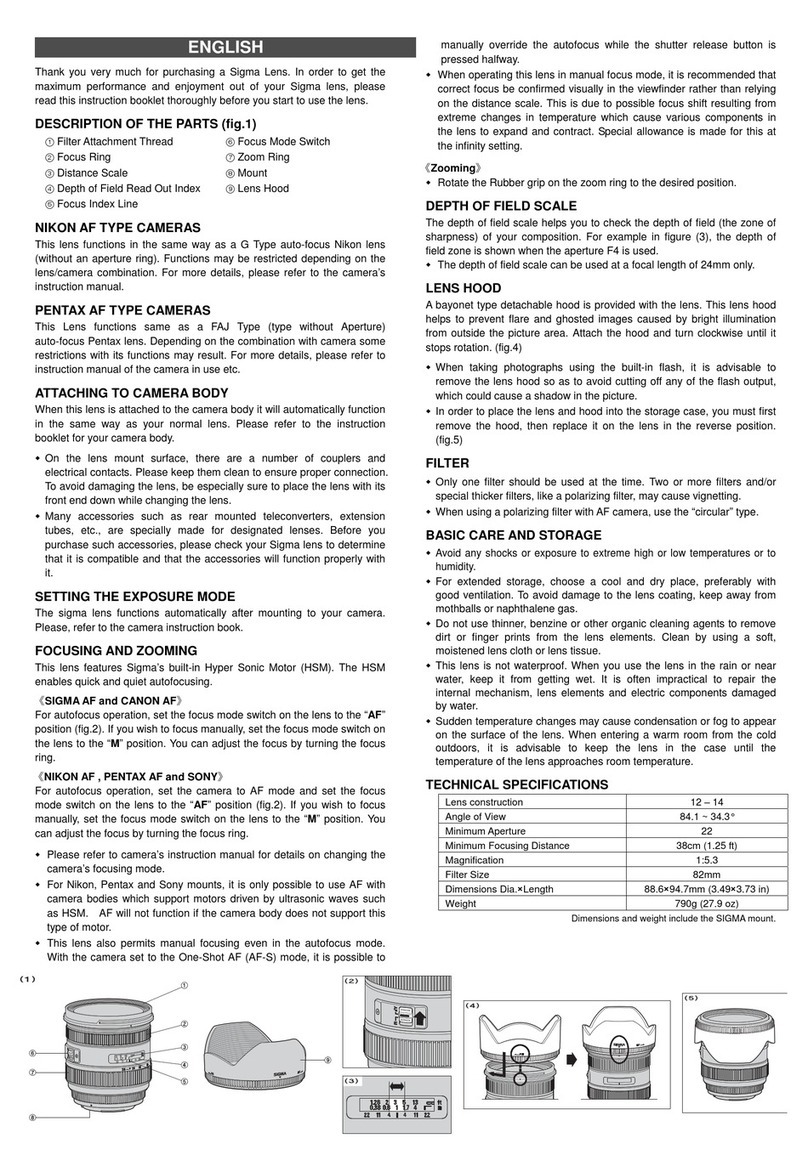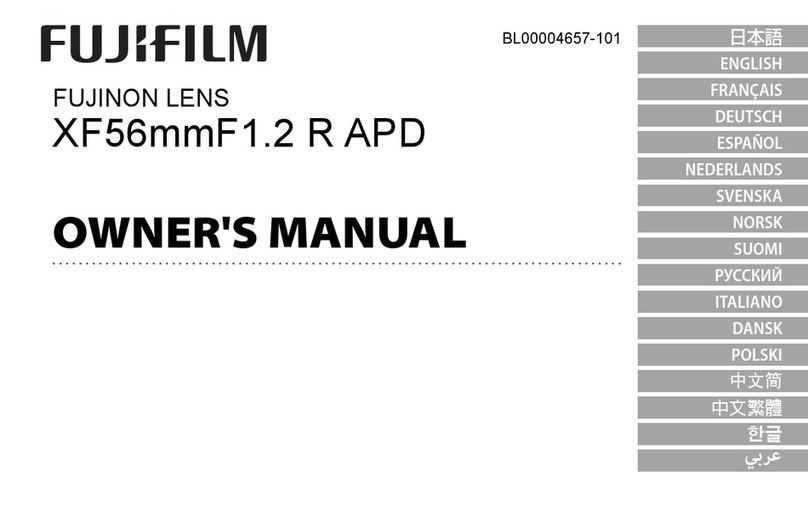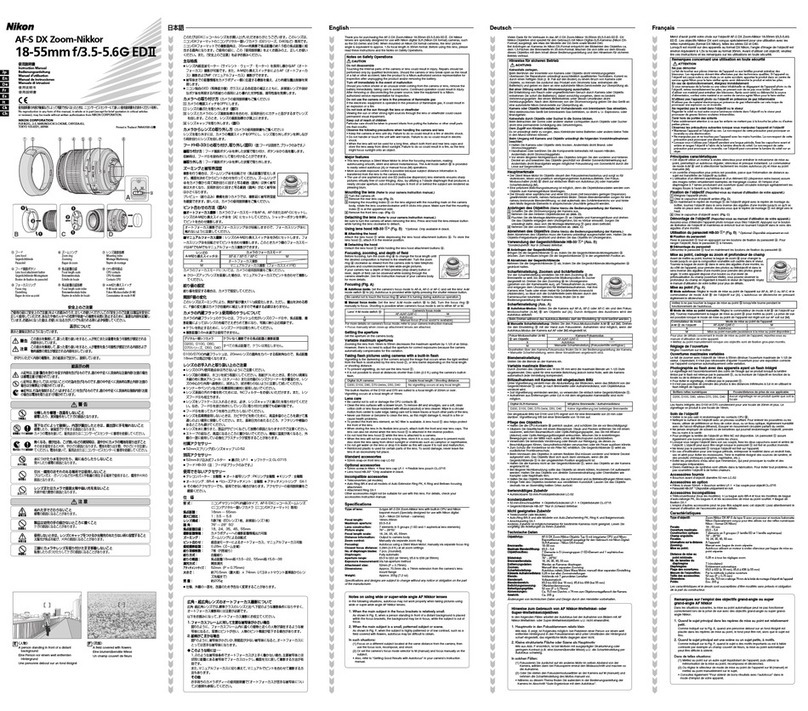露出補正段数
撮影距離(m)
フォーカスエリアの中に距離の異なるものが混ざってい
る場合、オートフォーカスでピントが合いにくいことが
あります。カメラの取扱説明書をご覧いただき、最適な
フォーカスモードを選んでください。
主な仕様
商品名(型名) E 30mm F3.5 Macro (SEL30M35)
35mm判換算焦点距離*1
(mm)
45
レンズ群一枚 6-7
画角 50°
最短撮影距離*2(m) 0.095
最大撮影倍率(倍)1.0
最小絞り f/22
フィルター径(mm) 49
外形寸法(最大径×長さ)
(約:mm) 62.0×55.5
質量(約:g) 138
*1ここでの35mm判換算焦点距離は、APS-Cサイズ相当
の撮像素子を搭載したレンズ交換式デジタルカメラで
の値を表します。
*2最短撮影距離とは、撮像素子面から被写体までの最短距
離を表します。
レンズの機構によっては、撮影距離の変化に伴って焦点
距離が変化する場合があります。記載の焦点距離は撮影
距離が無限遠での定義です。
同梱物
レンズ(1)、レンズフロントキャップ(1)、
レンズリヤキャップ(1)、レンズフード*
(1)、
印刷物一式
*出荷時、レンズに取り付けられています。
仕様および外観は、改良のため予告なく変更するこ
とがありますが、ご了承ください。
はソニー株式会社の商標です。
This instruction manual explains how to use lenses.
Precautions common to all lenses such as notes on use
are found in the separate “Precautions before using”. Be
sure to read both documents before using your lens.
This lens is designed for Sony α camera system E-mount
cameras. You cannot use it on A-mount cameras.
Notes on Use
When carrying a camera with the lens attached, always firmly
hold both the camera and the lens.
Precautions on using a flash
When using a flash, always remove the lens hood and shoot
at least 1 m (3.3 feet) away from your subject. With certain
combinations of lens and flash, the lens may partially block
the light of the flash, resulting in a shadow at the bottom of
the picture.
Vignetting
When using the lens, the corners of the screen become darker
than the center. To reduce this phenomena (called vignetting),
close the aperture by 1 to 2 stops.
Identifying the Parts
1 Lens hood index
2 Focusing ring
3 Lens contacts*
4 Mounting index
* Do not touch the lens contacts.
Attaching and Detaching the Lens
To attach the lens
(See illustration –.)
1
R
emove the rear and front lens caps and the
camera body cap.
You can attach/detach the front lens cap in two ways, (1)
and (2).
2Align the white index on the lens barrel with
the white index on the camera (mounting
index), then insert the lens into the camera
mount and rotate it clockwise until it locks.
Do not press the lens release button on the camera when
mounting the lens.
Do not mount the lens at an angle.
To remove the lens
(See illustration –.)
While holding down the lens release button on
the camera, rotate the lens counterclockwise
until it stops, then detach the lens.
Attaching the Lens Hood (supplied)
It is recommended that you use a lens hood to reduce flare
and ensure maximum image quality.
Align the red line on the lens hood with the
red line on the lens (hood index), then insert
the lens hood into the lens mount and rotate it
clockwise until the red point on the lens hood
is aligned with the red line on the lens (hood
index) and the lens hood clicks into place.
When using a built-in camera flash or a flash supplied with the
camera, remove the lens hood to avoid blocking the flash light.
You can attach a filter or front lens cap to the lens hood as
well.
Depending on the filter you use, you can attach the lens hood
after attaching the filter to the lens.
Focusing
There are three ways to focus.
• Auto focus
The camera focuses automatically.
• DMF (Direct manual focus)
After the camera focuses in auto focus, you can make a fine
adjustment manually.
• Manual focus
You focus manually.
For details on mode settings, refer to the instruction manual
supplied with the camera.
Macro photography
Precautions on using a commercially
available exposure meter or manual
flash shooting function
When shooting close to a subject with the E 30mm F3.5
Macro, the brightness of the lens is reduced.
When shooting in automatic exposure mode or metered
manual mode (for example, the camera’s AUTO mode), the
exposure is adjusted automatically.
When using a commercially available exposure meter
or shooting with the manual flash function available on
some external flash units, set the exposure higher than the
indicated value.
Exposure compensation
Shooting distance (m)
When two or more subjects at different distances are
overlapping in the AF area, it may be hard for the camera to
focus automatically. If this happens, refer to the instruction
manual of the camera and select the proper focus mode.
Specifications
Product name
(Model name)
E 30mm F3.5 Macro
(SEL30M35)
Equivalent 35mm-format
focal length*1(mm)
45
Lens groups-elements 6-7
Angle of view 50°
Minimum focus*2(m (feet)) 0.095 (0.32)
Maximum magnification (X) 1.0
Minimum f-stop f/22
Filter diameter (mm) 49
Dimensions (maximum
diameter × height)
(approx., mm (in.))
62.0×55.5
(2 1/2 × 2 1/4)
Mass (approx., g (oz)) 138 (4 7/8)
*1The value shown above for equivalent 35mm-format focal
length is for Interchangeable Lens Cameras equipped with an
APS-C sized image sensor.
*2Minimum focus is the shortest distance from the image
sensor to the subject.
Depending on the lens mechanism, the focal length may
change with any change in shooting distance. The focal
lengths given above assume the lens is focused at infinity.
Included items
Lens (1), Front lens cap (1), Rear lens cap (1),
Lens hood* (1), Set of printed documentation
* The lens hood is attached to the lens when the lens is
shipped from the factory.
Design and specifications are subject to change without
notice.
is a trademark of Sony Corporation.
Cette notice explique comment se servir des objectifs.
Les précautions communes à tous les objectifs, par
exemple les remarques sur l’emploi, se trouvent sur la
feuille « Précautions avant toute utilisation ». Veuillez
lire les deux documents avant d’utiliser votre objectif.
Votre objectif est conçu pour les appareils photo à monture
E de type Sony α. Il ne peut pas être utilisé pour les appareils
photo à monture A.
Remarques sur l’emploi
Lorsque vous portez un appareil photo avec l’objectif dessus,
tenez toujours fermement l’appareil photo et l’objectif.
Précautions concernant l’emploi d’un flash
Lorsque vous utilisez un flash, retirez toujours le parasoleil et
prenez vos photos à au moins 1 m (3,3 pieds) du sujet. Associé
à certains types de flash, l’objectif peut bloquer partiellement
la lumière du flash et produire un ombre au bas de l’image.
4-286-758-01(2)
©2011 Sony Corporation
SEL30M35
交換レンズ
Interchangeable Lens
Objectif interchangeable
取扱説明書
Operating Instructions
Mode d’emploi
Manual de instrucciones
E 30mm F3.5 Macro
E-mount
Printed in Japan
Vignetage
Lorsque l’objectif est utilisé, les coins de l’écran deviennent
plus sombres que le centre. Pour réduire ce phénomène
(appelé vignetage), fermez l’ouverture de 1 ou 2 crans.
Identification des éléments
1 Repère de parasoleil
2 Bague de mise au point
3 Contacts d’objectif *
4 Repère de montage
* Ne touchez pas les contacts d’objectif.
Pose et dépose de l’objectif
Pour poser l’objectif
(Voir l’illustration –.)
1Déposez les capuchons d’objectif avant et
arrière et le capuchon de l’appareil photo.
Vous pouvez poser et déposer les capuchons d’objectif
avant de deux façons, (1) et (2).
2Alignez le repère blanc du barillet d’objectif
sur le repère blanc de l’appareil photo
(repère de montage), puis posez l’objectif
sur la monture de l’appareil photo et
tournez-le dans le sens horaire de sorte qu’il
s’encliquette.
N’appuyez pas sur le bouton de libération de l’objectif sur
l’appareil photo lorsque vous posez l’objectif.
Ne posez pas l’objectif de biais.
Pour déposer l’objectif
(Voir l’illustration –.)
Tout en appuyant sur le bouton de libération de
l’objectif sur l’appareil photo, tournez l’objectif
dans le sens antihoraire jusqu’à l’arrêt, puis
déposez l’objectif.
Fixation du parasoleil (fourni)
Il est conseillé d’utiliser un parasoleil pour réduire la
lumière parasite et obtenir la meilleure image possible.
Alignez la ligne rouge du parasoleil sur la ligne
rouge de l’objectif (repère de parasoleil), puis
insérez le parasoleil sur la monture d’objectif et
tournez-le dans le sens horaire jusqu’à ce que
le point rouge du parasoleil s’aligne sur la ligne
rouge de l’objectif (repère de parasoleil) et que
le parasoleil s’encliquette.
Lorsque vous utilisez le flash intégré d’un appareil photo ou le
flash fourni avec un appareil photo, retirez le parasoleil pour
éviter de bloquer la lumière du flash.
Vous pouvez aussi poser un filtre ou un capuchon d’objectif
avant sur le parasoleil.
Avec certains filtres, vous pouvez fixer le parasoleil après avoir
mis le filtre sur l’objectif.
Mise au point
La mise au point peut être faite de trois façons.
• Autofocus
L’appareil photo fait automatiquement la mise au point.
• DMF (Mise au point manuelle directe)
Après la mise au point en autofocus, vous pouvez effectuer
un réglage plus fin manuellement.
• Mise au point manuelle
Vous faites vous-même la mise au point.
Pour le détail sur les réglages de mode, reportez-vous au
mode d’emploi fourni avec l’appareil photo.
Macrophotographie
Précautions à prendre lorsqu’un
posemètre du commerce ou la fonction
de prise de vue au flash manuel est
utilisé
Lors de la prise de vue rapprochée d’un sujet avec le E
30mm F3.5 Macro, la luminosité de l’objectif est réduite.
Lors de la prise de vue dans un mode d’exposition
automatique ou dans un mode à réglage manuel (par
exemple, le mode AUTO de l’appareil photo), l’exposition
s’ajuste automatiquement.
Lorsqu’un posemètre du commerce est utilisé ou lors de la
prise de vue avec la fonction de flash manuel disponible sur
certains flashs externes, réglez l’exposition plus haut que la
valeur indiquée.

